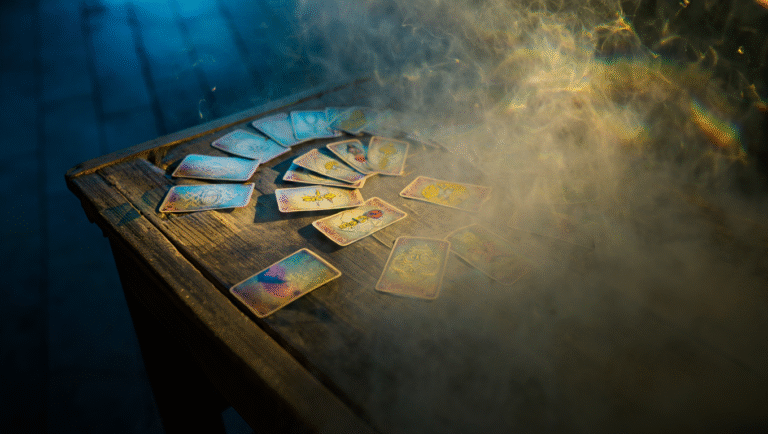Lesson 8: Tarot for Self-Reflection
Tarot might seem mysterious, but at its core, it’s a tool for self-reflection—no fortune-telling required. In today’s non-stop world, taking just 15 minutes with a deck and a journal can help you check in, notice patterns, and gently tweak your mindset. Whether you’re new to tarot or a seasoned reader, using cards for personal insight is simple, practical, and surprisingly grounded.
Why Use Tarot for Self-Reflection?
Think of tarot as a visual prompt for your inner dialogue. The cards don’t predict your future—they mirror your current thoughts, feelings, and choices. It’s less about “magic” and more about mindfulness.
“Tarot doesn’t give you answers—it helps you ask better questions.”
I discovered tarot during a stressful work phase. Instead of hoping for mystical guidance, I started pulling a card each morning, jotting down what came up, and noticing patterns over time. The result? More clarity, less autopilot, and some honest self-talk (sometimes with coffee stains on the page).
Case Study: The 15-Minute Tarot & Journal Routine
Let’s say you want to reflect on your week, check your mood, or prep for a big decision. Here’s a step-by-step process you can do in a lunch break or before bed.
What You’ll Need
- Your favorite tarot deck (see comparison below if you need ideas)
- A notebook or journal (digital or paper—no judgment)
- Pen, highlighter, or your favorite journaling app
- Optional: A cup of tea, candle, or calming playlist to set the mood
Step-by-Step: 15-Minute Self-Reflection Tarot Spread
- Settle in (2 minutes): Find a quiet spot. Take a few slow breaths. If you like, jot down today’s date and a word for your mood.
- Shuffle and draw cards (3 minutes): Shuffle your deck, thinking about a question or intention—examples: “What do I need to know today?”, “What am I overlooking?”, “How can I support myself?” Draw 1–3 cards.
- Note first impressions (2 minutes): Look at each card. What grabs your attention? A symbol, color, or character? Write down the first things that pop into your head, even if they seem random.
- Reflect and connect (5 minutes): Ask yourself: How does this card relate to what’s on my mind? What might it be pointing out? Be honest—sometimes the insights are obvious, sometimes subtle.
- Set an action or affirmation (3 minutes): Based on your reflection, write a simple action step or affirmation for the day. Example: “I’ll take a five-minute walk at lunch” or “I’m open to new ideas.”
Quick Tarot Journaling Prompts
- What am I learning about myself today?
- What’s one thing I can let go of?
- Where do I need more kindness or rest?
- What’s my next right step?
Choosing a Deck: Top Picks for Self-Reflection
You don’t need a fancy or rare deck for effective self-reflection. Here’s a quick table with some of the best beginner-friendly and introspective tarot decks, including honest pros and cons.
| Name | Key Feature | Size/Material | Price range | Amazon link |
|---|---|---|---|---|
| Rider-Waite Tarot | Classic imagery, tons of resources | Standard, sturdy cardstock | $15–25 | Check price on Amazon |
| Modern Witch Tarot | Diverse, modern artwork | Matte finish, regular size | $18–28 | See today’s deal |
| Light Seer’s Tarot | Colorful, intuitive | Flexible, high-quality | $20–30 | Check price on Amazon |
| Everyday Tarot Mini | Compact, great for travel | Small, portable box | $10–16 | See today’s deal |
Tip: Don’t overthink your choice. Any deck you like is a good deck for self-reflection.
Best Journals & Accessories for Tarot Reflection
-
Leuchtturm1917 Medium Notebook – High-quality, durable, and comes in dozens of colors. Check price on Amazon
Pros: Lays flat, numbered pages.
Cons: Pricier than basic journals.
Best for: Daily or long-term tarot journaling. -
Moleskine Classic Notebook – Sleek, minimalist, and reliable. See today’s deal
Pros: Classic look, smooth paper.
Cons: Some bleed-through with markers.
Best for: On-the-go notes. -
Evernote App – For digital journaling with tags and search. Try Evernote here
Pros: Free tier, accessible anywhere.
Cons: Subscription for advanced features.
Best for: Tech-savvy journalers.
Quick-Start Checklist: Your 15-Minute Self-Reflection Tarot Session
- Pick your deck and journal
- Set timer for 15 minutes
- Shuffle and draw 1–3 cards
- Write first impressions
- Ask yourself what the cards might reflect
- Set a small action/affirmation
- Optional: Take a photo for your digital archive
Helpful Resources & Further Reading
- Biddy Tarot: How to Start a Tarot Journal
- Tarot.com: Using Tarot for Self-Discovery
- Light Seer’s Tarot Deck on Amazon
Final Thoughts
Tarot isn’t about destiny—it’s about clarity. Used with honest curiosity (and maybe a little humor), it’s a simple practice for real-life self-growth. Try it for a week and see what comes up—you might be surprised.
Some links may be affiliate. You pay the same price, and this blog may earn a small commission.
Thank you for reading! If you have questions or want to share your own tarot journaling experience, feel free to leave a comment below or connect on social media. Remember, your tarot practice is uniquely yours—there are no strict rules, just tools to support your self-reflection journey. Keep it practical, keep it honest, and most importantly, keep it kind to yourself.



